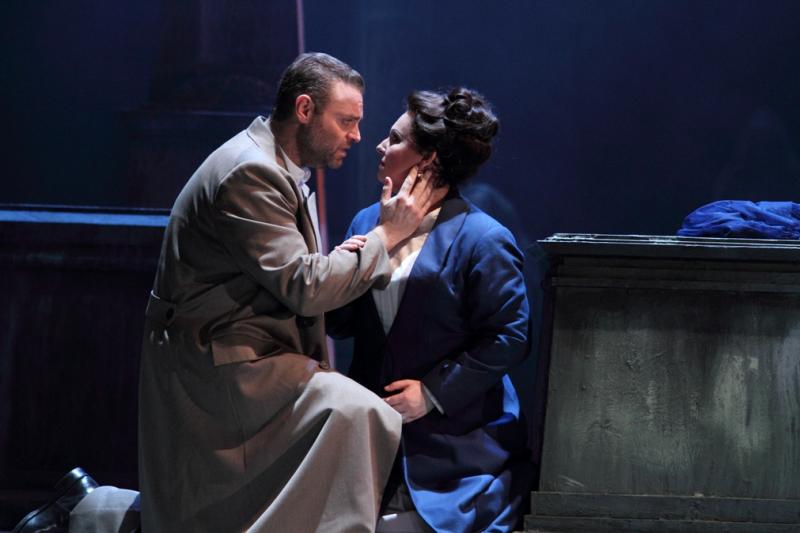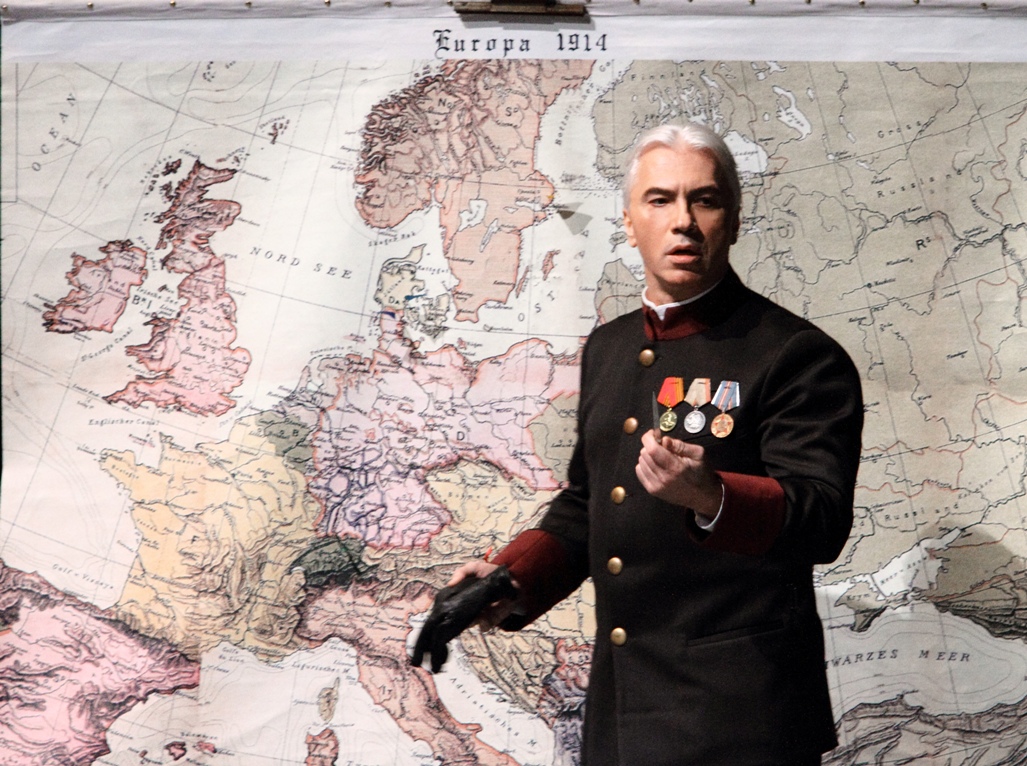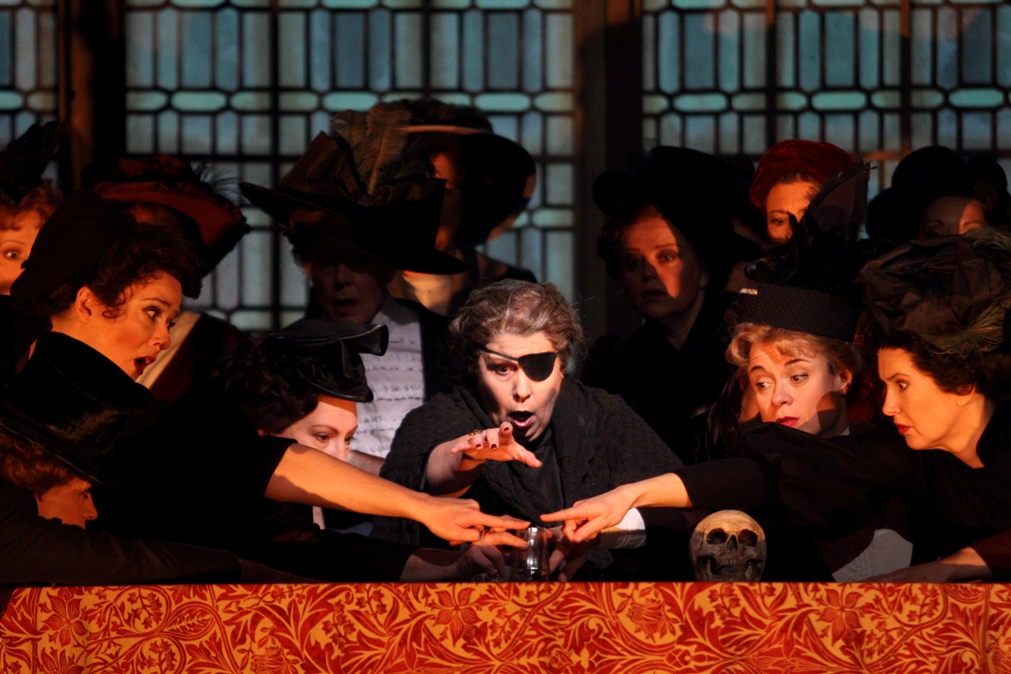Un Ballo in Maschera, Royal Opera | reviews, news & interviews
Un Ballo in Maschera, Royal Opera
Un Ballo in Maschera, Royal Opera
Shining moments and star voices in mostly drab Verdi

Covent Garden’s masked balls circling around the New Year feature not the seasonal bourgeois Viennese couple and a bat-winged conspirator but a king, his best friend’s wife and – excessively so in this production – the grim reaper.
That's surprising from young German director Katharina Thoma, whose convalescent-ward jolt in Strauss’s Ariadne auf Naxos at Glyndebourne I was among the few to admire. Thoma nominally updates Verdi’s 17th century Boston or 18th century Stockholm to Mitteleuropa on the eve of the First World War, but Soutra Gilmour’s stage designs are drab, the few new ideas ineptly executed and the overall feel as conventional as any of Elijah Moshinsky’s mannequin-parade Royal Opera Verdi productions from the 1980s and 1990s. Much is made of what Elisabetta in Verdi's Don Carlo calls "the peace of the tomb": as it's Sarajevo assassination time, everyone is half in love with easeful death, and graveyard statuary comes to life as a zombie movement group. The moments in which the main tomb is wheeled onstage as platform for the principal characters are clumsy, especially so when the conspirators lift Amelia on it while husband Riccardo is shoved symbolically - but at odds with the realistic context - into an open grave.
 It also transpires – and this Thoma's Glyndebourne Ariadne couldn’t have told us – that she doesn’t know how to handle large groups, leaving choreographer Lucy Burge to do some unusually staid infilling, and nor does Oren: this is the messiest contribution I’ve heard from the Royal Opera Chorus, conspicuously so in the first and last scenes yesterday night, and it looked as if unclear direction from the pit was to blame.
It also transpires – and this Thoma's Glyndebourne Ariadne couldn’t have told us – that she doesn’t know how to handle large groups, leaving choreographer Lucy Burge to do some unusually staid infilling, and nor does Oren: this is the messiest contribution I’ve heard from the Royal Opera Chorus, conspicuously so in the first and last scenes yesterday night, and it looked as if unclear direction from the pit was to blame.
Perhaps Calleja can’t be directed. His movements are stiff and generic, while his distinctive tone – vibrant to some, bleaty-sounding to me – gets in the way of the Verdian line. He also ought to have a bit more fun with the irresponsible ruler in the carefree mode of the opera’s early stages. But then Serena Gamberoni’s stock, charmless page boy Oscar doesn’t either; the Parisian Opéra-Comique touch is dully handled by Oren and there’s no panache onstage, with military manoevres going on during what should be a sparkling Act One Scene One galop-finale. Dmitri Hvorostovsky (pictured above) as friend and minister Renato has to push sharp-ish at times, but this cello among great voices produces some beautiful legato singing, peerlessly so in the calmer section of the big aria “Eri tu, and sets up high expectations with the typically long phrases of his first cavatina.
 Energy goes up a notch after the first 20 minutes with the arrival of witch Ulrica, true Verdi mezzo Marianne Cornetti as a fashionable séance-mistress delivering baleful prophecies as usual (pictured left with women of the Royal Opera Chorus). I can’t hear her as Brünnhilde, a role the programme tells us she’s tackling, but on the other hand I also can’t wait for Liudmyla Monastyrska to travel north of the Alps from her Verdi calling-cards and essay Wagner’s Ring. More dramatic than lyric, her Amelia is a size too big, but better that than too small or top-less.
Energy goes up a notch after the first 20 minutes with the arrival of witch Ulrica, true Verdi mezzo Marianne Cornetti as a fashionable séance-mistress delivering baleful prophecies as usual (pictured left with women of the Royal Opera Chorus). I can’t hear her as Brünnhilde, a role the programme tells us she’s tackling, but on the other hand I also can’t wait for Liudmyla Monastyrska to travel north of the Alps from her Verdi calling-cards and essay Wagner’s Ring. More dramatic than lyric, her Amelia is a size too big, but better that than too small or top-less.
Monastyrska is also a superb musician and technician, singing stylish pianissimos and dominating ensembles like no other Verdi soprano I’ve heard (that was evident right from the start in her Covent Garden debut as Aida). Given the right director, she can act too, but here she simply looks noble or stricken, dignified against the graveyard monuments come to life in the midnight scene and giving the good mother bit – for Amelia's son is onstage a great deal – her best shot.
It’s Oren’s fault as much as Thoma’s if the interest comes and goes. Given such strong voices, the set pieces back in Amelia’s and Renato’s home can’t go wrong – and I’d recommend you go and see this production for these alone - but all life bleeds away long before the assassination. Verdi’s stunning mixture of experiment and tradition deserves a lot better than this.
- Un ballo in maschera at the Royal Opera until 7 January 2015
- BBC Radio 3 broadcast on 10 January
rating
Share this article
The future of Arts Journalism
You can stop theartsdesk.com closing!
We urgently need financing to survive. Our fundraising drive has thus far raised £49,000 but we need to reach £100,000 or we will be forced to close. Please contribute here: https://gofund.me/c3f6033d
And if you can forward this information to anyone who might assist, we’d be grateful.

Subscribe to theartsdesk.com
Thank you for continuing to read our work on theartsdesk.com. For unlimited access to every article in its entirety, including our archive of more than 15,000 pieces, we're asking for £5 per month or £40 per year. We feel it's a very good deal, and hope you do too.
To take a subscription now simply click here.
And if you're looking for that extra gift for a friend or family member, why not treat them to a theartsdesk.com gift subscription?
more Opera
 La bohème, Opera North review - still young at 32
Love and separation, ecstasy and heartbreak, in masterfully updated Puccini
La bohème, Opera North review - still young at 32
Love and separation, ecstasy and heartbreak, in masterfully updated Puccini
 Albert Herring, English National Opera review - a great comedy with depths fully realised
Britten’s delight was never made for the Coliseum, but it works on its first outing there
Albert Herring, English National Opera review - a great comedy with depths fully realised
Britten’s delight was never made for the Coliseum, but it works on its first outing there
 Carmen, English National Opera review - not quite dangerous
Hopes for Niamh O’Sullivan only partly fulfilled, though much good singing throughout
Carmen, English National Opera review - not quite dangerous
Hopes for Niamh O’Sullivan only partly fulfilled, though much good singing throughout
 Giustino, Linbury Theatre review - a stylish account of a slight opera
Gods, mortals and monsters do battle in Handel's charming drama
Giustino, Linbury Theatre review - a stylish account of a slight opera
Gods, mortals and monsters do battle in Handel's charming drama
 Susanna, Opera North review - hybrid staging of a Handel oratorio
Dance and signing complement outstanding singing in a story of virtue rewarded
Susanna, Opera North review - hybrid staging of a Handel oratorio
Dance and signing complement outstanding singing in a story of virtue rewarded
 Ariodante, Opéra Garnier, Paris review - a blast of Baroque beauty
A near-perfect night at the opera
Ariodante, Opéra Garnier, Paris review - a blast of Baroque beauty
A near-perfect night at the opera
 Cinderella/La Cenerentola, English National Opera review - the truth behind the tinsel
Appealing performances cut through hyperactive stagecraft
Cinderella/La Cenerentola, English National Opera review - the truth behind the tinsel
Appealing performances cut through hyperactive stagecraft
 Tosca, Royal Opera review - Ailyn Pérez steps in as the most vivid of divas
Jakub Hrůša’s multicoloured Puccini last night found a soprano to match
Tosca, Royal Opera review - Ailyn Pérez steps in as the most vivid of divas
Jakub Hrůša’s multicoloured Puccini last night found a soprano to match
 Tosca, Welsh National Opera review - a great company reduced to brilliance
The old warhorse made special by the basics
Tosca, Welsh National Opera review - a great company reduced to brilliance
The old warhorse made special by the basics
 BBC Proms: The Marriage of Figaro, Glyndebourne Festival review - merriment and menace
Strong Proms transfer for a robust and affecting show
BBC Proms: The Marriage of Figaro, Glyndebourne Festival review - merriment and menace
Strong Proms transfer for a robust and affecting show
 BBC Proms: Suor Angelica, LSO, Pappano review - earthly passion, heavenly grief
A Sister to remember blesses Puccini's convent tragedy
BBC Proms: Suor Angelica, LSO, Pappano review - earthly passion, heavenly grief
A Sister to remember blesses Puccini's convent tragedy
 Orpheus and Eurydice, Opera Queensland/SCO, Edinburgh International Festival 2025 review - dazzling, but distracting
Eye-popping acrobatics don’t always assist in Gluck’s quest for operatic truth
Orpheus and Eurydice, Opera Queensland/SCO, Edinburgh International Festival 2025 review - dazzling, but distracting
Eye-popping acrobatics don’t always assist in Gluck’s quest for operatic truth

Add comment